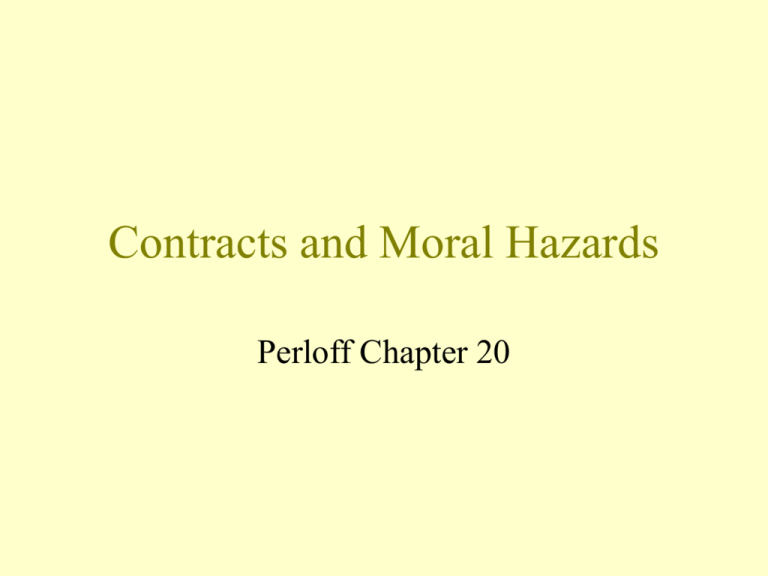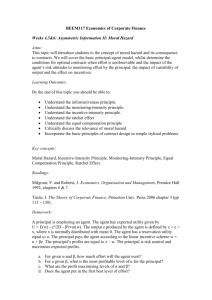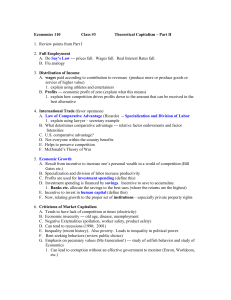Contracts and Moral Hazards
advertisement

Contracts and Moral Hazards Perloff Chapter 20 Principal Agent Problem • Contract with an individual who’s actions are not observed. • Individual may not act fully in your interests. • Examples – Shirking at work. – Insurance. • Principal contracts with the agent to take an action which benefits the principal Contracts and Efficiency • Types of contract – Fixed fee: independent of actions, states of nature or outcome. – Hire contract: either hourly or piece rate. – Contingent: dependent on the state of nature. • Type depends on what the principal can observe. • Efficiency: – In production requires sum of principal and agent’s payoffs are maximised. – In risk: Requires that least risk averse individual bears the risk. Efficient Contract in the Absence of Risk • Maximises joint profits. • Incentive compatibility: – The contract ensures that it is in the agents best interests to take actions which maximise joint profits. a R a 12 a p 24 0.5a Agent’s marginal revenue, $ per carving (a) Agent’s Problem 24 12 e MC Demand MR 0 12 72 24 a, Duck carvings per day (b) Profits Agent’s profit, $ Maximising Joint Profit and a Fixed Fee Contract E π, Joint profit 24 0 E* 12 π – 48, Agent’s profit 24 a, Duck carvings per day Hire Contract • Principal allows agent to retain $12 for each carving sold. – Agent has to pay $12 to purchase each duck. – Therefore indifferent between participating or not. – With supervision, instructed to sell the profit maximising q he gets zero profit and fails to join. • Principal pays $14. – Agent tries to maximise sales not profits. – If agent controls sales their profit is: a R a 14 a • Contract is not incentive compatible • Contingent contract (dependent on revenue) • Agent gets ¾ of the revenue. • Not Incentive compatible 24 18 12 e* e MC MR 3 MR* = – MR 4 0 8 12 24 a, Duck carvings per day (b) Profits Agent’s profit, $ Revenue sharing Agent’s marginal revenue, $ per carving (a) Agent’s Problem E 72 64 π, Joint profit E* 24 0 8 3 – R – 12a, 4 Agent’s profit 12 16 24 a, Duck carvings per day Agent’s profit, $ Profit Sharing 72 π, Joint profit 1 – π, Agent’s profit 3 24 0 12 24 a, Duck carvings per day Asymmetric Information • Principal is not able to fully monitor sales. • Fixed Fee – No opportunity to exploit. • Hire contract – Agent may under report sales in order to retain more than just $12. – Unless all profit is retained, still incentive incompatible. • Revenue sharing. – Agent can retain larger share of revenues than specified. – If all revenue is retained, it becomes incentive compatible, the agent is the firm. • Profit sharing – Over-reporting cost, under reporting revenue leads to inefficiency. Trade off between efficiency in production and risk bearing • Lawyer (agent) working for client (principal). – Whether payoff occurs depends on state of nature (jury). – Size of payoff depends on lawyers actions. • Fixed fee. – Agent has little incentive to work, therefore production inefficiency. – Agent bears all the risk, they are likely to be risk averse. • Client gets a fixed payment – Agent works to the point where MC=MB. – Risk is all borne by the principal. – Client may not agree to this type of contract because of moral hazard. How do they know they are paid enough. • Hourly fee – Moral Hazard problem, agent lies about the hours worked. – Risk all borne by the principal. • Contingent – Like the revenue sharing contract this encourages sub optimal effort. – Risk is shared in proportion to the sharing of the payout. Payments linked to production or profit • • • • Employer:employee contracts Hourly payments or fixed salary. Neither rewards actual effort. Two alternatives: – Payment linked to individual output. – Payment linked to output or profit. • Both require monitoring. Payment by piece rate • Payment directly linked to output. • Difficulties: – Measuring output. – They can encourage the wrong sort of behaviour. – Persuading workers to accept them. Contingent contract • Some workers, managers, have productivity which is difficult to quantify. • Lump sum bonus. • Stock option. – Option to buy stock at a specified price. – Act as golden handcuffs. Monitoring • An alternative to piece rate or contingent contract in avoiding moral hazard. • Intensive monitoring eliminates the problem. • May be costly and/or counter-productive. – Lower morale. – Workers in remote locations (sales force). • Methods to reduce the costs of monitoring. – Bonding – Efficiency wage. Bonding • Agent provides a bond which is forfeited if they fail to perform. – A bond to prevent shirking. – Raises the cost of losing job. – The higher the value of the bond the less frequently an employee needs to be monitored. • Problems with the bond. – The possibility of the principal making is a disincentive to the agent. – May act as a barrier to entry. Alternatives to bonding • Bonds act by increasing the cost of being fired. • Deferred payments. – Low wage initially. – Over time shirkers a fired, those that remain see wages increase. • Efficiency wage. – If an employee can immediately work elsewhere and earn the same wage, they lose nothing. – Pay a higher (efficiency) wage than would otherwise be justified. – Problem is all firms raise the wage and unemployment results. Contract choice • Firms may offer a choice of contracts as a means of eliminating moral hazard. • Contracts act as a screening mechanism. • Example: – Contingent contract: No salary plus 30% of sales. – Fixed fee: $25000 Example of contract choice








